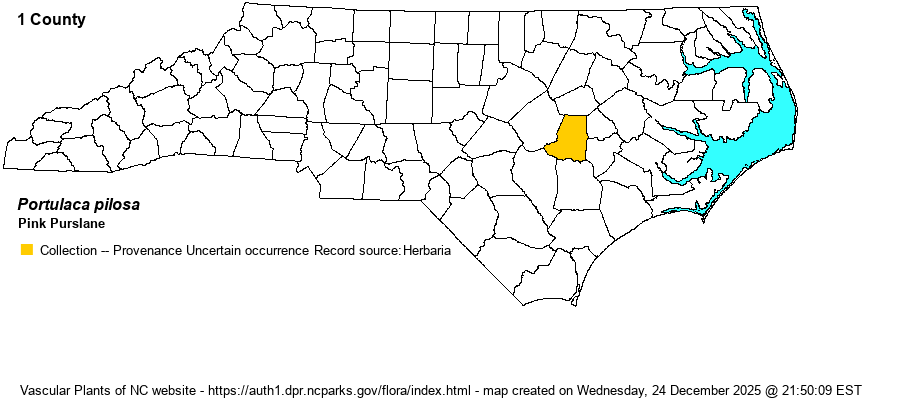| Author | L. | |
| Distribution | Maggie Whitson at Duke University alerted the website editors that nearly all North Carolina records for Portulaca pilosa, a native species, in the various herbaria collections are actually of the non-native P. amilis. As a result, one of the editors (Sorrie) checked all online specimens on the SERNEC database and also at UNC-CH herbarium. He found just one specimen from Wayne County.
The native range of this species is now greatly blurred by the presence of the non-native P. amilis across most of the Southeast. It perhaps ranges north only to SC. | |
| Abundance | If native to NC, seemingly quite rare, and limited to the Coastal Plain. Though it is highly unlikely that the only populations in the state are limited to Wayne County, in the center of the Coastal Plain, the website is giving the state rank of [S1?] for the present time, quite different from the NCNHP's rank of S3, which clearly referred to what is now known to be P. amilis (which is ranked as SE). And, the species deserves to be at least placed on the NCNHP's Watch List; this website give a [W7] status -- poorly-known but to be tracked as a Watch List species. | |
| Habitat | The Wayne County specimen label states: "Waste ground, seed mill on NC 55, 5 miles east of Mount Olive." This is not the sort of place where a native species should inhabit, and calls into question the native status of P. pilosa in NC. As a result, it appears best to consider the Wayne County specimen as Provenance Uncertain -- not only because of the ruderal habitat but because there are no other confirmed records closer to SC than Wayne County, far from that state's border. | |
| Phenology | Probably blooms from May or June into October, but these dates refer now to P. amilis. Fruits soon after flowering. | |
| Identification | Both of these species have mostly prostrate stems, with much branching. This native species has narrow (linear to lanceolate) leaves. P. amilis has quite widely elliptic and fleshy leaves, somewhat flattened in cross-section; those of P. pilosa are somewhat rounded in cross-section. Both species has large deep rose to purple-rose flowers, with 5 rounded to squared-off petals, and about 3/4-inch across; they bloom close to the ground. These flowers are quite attractive. Weakley's (2018) key separates these by -- P. amilis with "leaves flattened in cross-section, >2.5 mm wide, obovate to spatulate" as opposed to P. pilosa with "Leaves terete to hemispherical in cross-section, usually < 2 mm wide, linear to lanceolate". You must assume in NC that a bright rose-colored flowering Portulaca which is prostrate with fleshy leaves to be the non-native P. amilis until proven otherwise; this exotic has greatly increased in our area in the past few decades. | |
| Taxonomic Comments | See above. P. pilosa has long been a valid species in the Southeast, but now its range is clouded with the great spread northward of P. amilis.
| |
| Other Common Name(s) | Kiss-me-quick | |
| State Rank | S3 [S1?] | |
| Global Rank | G5 | |
| State Status | [W7] | |
| US Status | | |
| USACE-agcp | FACU link |
| USACE-emp | FACU link |

